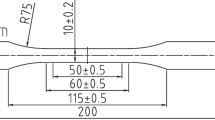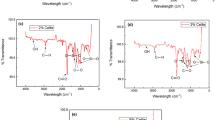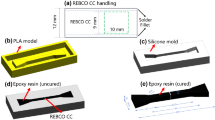Abstract
REBCO-coated conductor is widely used in various HTS power applications. The HTS coils for power applications are generally impregnated with epoxy resin to enhance their mechanical stability, and the coil conductors would be subjected to transverse compressive loading in these applications. Although the effect of various operating conditions on the quench characteristics of REBCO-coated conductor have been investigated, the effects of compressive stress on quench characteristics of epoxy-impregnated REBCO-coated conductor has rarely been reported. This study examined the effects of transverse compressive loading on the minimum quench energy (MQE) and normal zone propagation velocities (NZPV) of epoxy-impregnated REBCO-coated conductor. The critical current of the conductor shows little degradation when transverse compressive stress is applied up to 80 MPa. Under the same compressive stress, the MQE decreases but the NZPV increases with the transport current. For fixed transport current, compressive stress increases the thermal contact conductance between conductor and epoxy which allows the heater energy of the conductor dissipating faster towards the surrounding epoxy, resulting in the increase of MQE and decrease of NZPV when increasing transverse compressive stress. The results indicate that higher compressive stress is helpful to decrease the quench damage of the conductor.









Similar content being viewed by others
References
Sundaram, A., Zhang, Y., Knoll, A.R., Abraimov, D., Brownsey, P., Kasahara, M., Carota, G.M., Nakasaki, R., Cameron, J.B., Schw, G., Hope, L.V., Schmidt, R.M., Kuraseko, H., Fukushima, T., Hazelton, D.W.: 2G HTS wires made on 30 μm thick Hastelloy substrate. Supercond. Sci. Technol. 29(10), 104007 (2016)
Zhang, Y., Lehner, T., Fukushima, T., Sakamoto, H., Hazelton, D.W.: Progress in production and performance of second generation (2G) HTS wire for practical applications. IEEE Trans. Appl. Supercond. 24(5), 7500405 (2014)
Bergen, A., Andersen, R., Bauer, M., Boy, H., Brake, M.T., Brutsaert, P., Bührer, C., Dhallé, M., Hansen, J., Kate, H.T., Kellers, J., Krause, J., Krooshoop, E., Kruse, C., Kylling, H., Pilas, M., Pütz, H., Rebsdorf, A., Reckhard, M., Seitz, E., Springer, H., Song, X.W., Tzabar, N., Wessel, S., Wiezoreck, J., Winkler, T., Yagotyntsev, K.: Design and in-field testing of the world’s first ReBCO rotor for a 3.6 MW wind generator. Supercond. Sci. Technol. 32, 125006 (2019)
Antonio, C.S., Enrique-Luis, M.I., Enrique, R.A., África, L.R.: Technical approach for the inclusion of superconducting magnetic energy storage in a smart city. Energy. 158, 080–1091 (2018)
Hahn, S., Kim, K., Kim, K., Hu, X., Painter, T., Dixon, I., Kim, S., Bhattarai, K.R., Noguchi, S., Jaroszynski, J., Larbalestier, D.C.: 45.5-tesla direct-current magnetic field generated with a high-temperature superconducting magnet. Nature. 570(7762), 496–499 (2019)
Ariyama, T., Matsusda, N., Matsuo, R., Fuchida, Y., Kojima, A., Takao, T.: Study on heat transfer characteristics HTS tapes of epoxy-impregnated conduction-cooled coils using winding pack model. IEEE Trans. Appl. Supercond. 27(4), 8800106 (2017)
Matsuda, T., Okamura, T., Hamada, M., Matsumoto, S., Ueno, T., Piao, R., Yanagisaw, Y., Maeda, H.: Degradation of the performance of an epoxy-impregnated REBCO solenoid due to electromagnetic forces. Cryogenics. 90, 47–51 (2018)
Shin, H., Gorospe, A.: Characterization of transverse tensile stress response of critical current and delamination behaviour in GdBCO coated conductor tapes by anvil test. Supercond. Sci. Technol. 27(2), 25001 (2014)
Bonura, M., Senatore, C.: Temperature and field dependence of the quench propagation velocity in industrial REBCO coated conductors. IEEE Trans. Appl. Supercond. 27(4), 6600705 (2017)
Bae, J.H., Eom, B.Y., Sim, K.D., Cho, J.W.: Minimum quench energy characteristic of YBCO coated conductor with different stabilizer thickness. IEEE Trans. Appl. Supercond. 23(3), 4600404 (2013)
Park, H.Y., Kim, A.R., Park, M., Yu, I.K., Eom, B.Y., Bae, J.H., Kim, S.H., Sim, K., Sohn, M.H.: Analysis of temperature dependent quench characteristics of the YBCO coated conductor. IEEE Trans. Appl. Supercond. 20(3), 2122–2125 (2010)
Wang, X., Trociewitz, U.P., Schwartz, J.: Self-field quench behaviour of YBa2Cu3O7−δ coated conductors with different stabilizers. Supercond. Sci. Technol. 22(8), 085005 (2009)
Takao, T., Koizuka, S., Oi, K., Ishiyama, A., Kato, J., Machi, T., Nakao, K., Shiohara, Y.: Characteristics of compressive strain and superconducting property in YBCO coated conductor. IEEE Trans. Appl. Supercond. 17(2), 3517–3519 (2007)
Wang, X., Trociewitz, U.P., Schwartz, J.: Near-adiabatic quench experiments on short YBa2Cu3O7-δ coated conductors. J. Appl. Phys. 101(5), 053904 (2007)
Dou, R., Ge, T., Liu, X., Wen, Z.: Effects of contact pressure, interface temperature, and surface roughness on thermal contact conductance between stainless steel surfaces under atmosphere condition. Int. J Heat Mass Tran. 94, 156–163 (2016)
Sponagle, B., Groulx, D.: Measurement of thermal interface conductance at variable clamping pressures using a steady state method. Appl. Therm. Eng. 96, 671–681 (2016)
Grether, A., Scheuerlein, C., Ballarino, A., Bottura, L.: Electromechanical behaviour of REBCO tape lap splices under transverse compressive loading. Supercond. Sci. Technol. 29, 074004 (2016)
Fleiter, J., Ballarino, A.: In-field electrical resistance at 4.2 K of REBCO splices. IEEE Trans. Appl. Supercond. 27(4), 6603305 (2017)
Bonura, M., Senatore, C.: An equation for the quench propagation velocity valid for high field magnet use of REBCO coated conductors. Appl. Phys. Lett. 108(24), 242602 (2016)
Funding
This work is supported in part by the National Magnetic Confinement Fusion Science Program under Grant 2017YFE0301402, in part by the National Nature Science Foundation of China under Grant 51605048.
Author information
Authors and Affiliations
Corresponding authors
Additional information
Publisher’s note
Springer Nature remains neutral with regard to jurisdictional claims in published maps and institutional affiliations.
Rights and permissions
About this article
Cite this article
Liu, L., Chai, C., Yang, Y. et al. Effect of Transverse Compressive Loading on the Quench Characteristics of Epoxy-Impregnated REBCO-Coated Conductor. J Supercond Nov Magn 33, 3197–3203 (2020). https://doi.org/10.1007/s10948-020-05571-6
Received:
Accepted:
Published:
Issue Date:
DOI: https://doi.org/10.1007/s10948-020-05571-6




